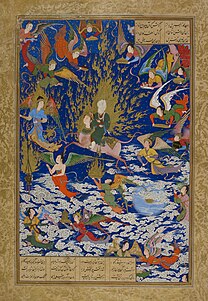 W
WIn the Abrahamic religions, Gabriel is an archangel, first described in the Hebrew Bible.
 W
WThe Annunciation, also referred to as the Annunciation to the Blessed Virgin Mary, the Annunciation of Our Lady, or the Annunciation of the Lord, is the Christian celebration of the announcement by the Archangel Gabriel to the Blessed Virgin Mary that she would conceive and become the mother of Jesus, the Jewish messiah and Son of God, marking His Incarnation. Gabriel told Mary to name her son Jesus, meaning "YHWH is salvation".
 W
WThe Israʾ and Miʿraj are the two parts of a Night Journey that, according to Islam, the Islamic prophet Muhammad took during a single night around the year 621. Within Islam it signifies both a physical and spiritual journey. The Quran surah al-Isra contains an outline account, while greater detail is found in the hadith collections of the reports, teachings, deeds and sayings of Muhammad. In the accounts of the Israʾ, Muhammad is said to have traveled on the back of a winged baby-horse-like white beast, called Buraq, to "the farthest mosque". By tradition this mosque, which came to represent the physical world, was identified as the Al-Aqsa Mosque in Jerusalem. At Masjid-e-Aqsa, Muhammad is said to have led the other prophets in prayer. His subsequent ascent into the heavens came to be known as the Miʿraj. Muhammad's journey and ascent is marked as one of the most celebrated dates in the Islamic calendar.
 W
WJabal an-Nour is a mountain near Mecca in the Hejazi region of Saudi Arabia. The mountain houses the grotto or cave of Hira', which holds tremendous significance for Muslims throughout the world, as the Islamic prophet Muhammad is said to have spent time in this cave meditating, and it is widely believed that it was here that he received his first revelation, which consisted of the first five ayats of Surah Al-Alaq from the angel Jibra'il. It is one of the most popular tourist attractions in Makkah. The mountain itself is barely 640 m (2,100 ft) tall; nonetheless one to two hours are needed to make the strenuous hike to the cave. There are 1750 steps to the top which, even for a fit individual, can take anywhere between half an hour and one-and-a-half hours.
 W
WMuhammad's first revelation was an event described in Islamic tradition as taking place in 610 AD, during which the Islamic prophet, Muhammad was visited by the angel Jibrīl, known as Gabriel in English, who revealed to him the beginnings of what would later become the Qur’an. The event took place in a cave called Hira, located on the mountain Jabal an-Nour, near Mecca. According to Mubarakpuri, the exact date of this event was Monday, the 21st of Ramadan just before sunrise, i.e. August 10, 610 C.E. – when Muhammad was 40 lunar years, 6 months and 12 days of age, i.e. 39 solar years, 3 months and 22 days.
 W
WGabriel's Revelation, also called Hazon Gabriel or the Jeselsohn Stone, is a stone tablet with 87 lines of Hebrew text written in ink, containing a collection of short prophecies written in the first person. It is sometimes dated to the late 1st century BCE or early 1st century CE and is considered important for understanding Jewish messianic expectations in the Second Temple period.
 W
WThe Book of Giants is an apocryphal Jewish book which expands the primeval creation to end of time narrative of the Hebrew Bible and, by its multifaceted elaborations on divine decrees of warning and doom, ties the ancient prophet Enoch closer to his generally recognized 'storyline' than does even the story's principal treatise of 1 Enoch. Together with 1 Enoch's Book of Watchers, as Enochian scholar James C. VanderKam maintains, "it stands as an attempt to explain how it was that wickedness had become so widespread and muscular before the flood; in so doing, it also supplies the reason why God was more than justified in sending that flood." The Giants discovery at Qumran dates the text's creation to before the 2nd century BC.